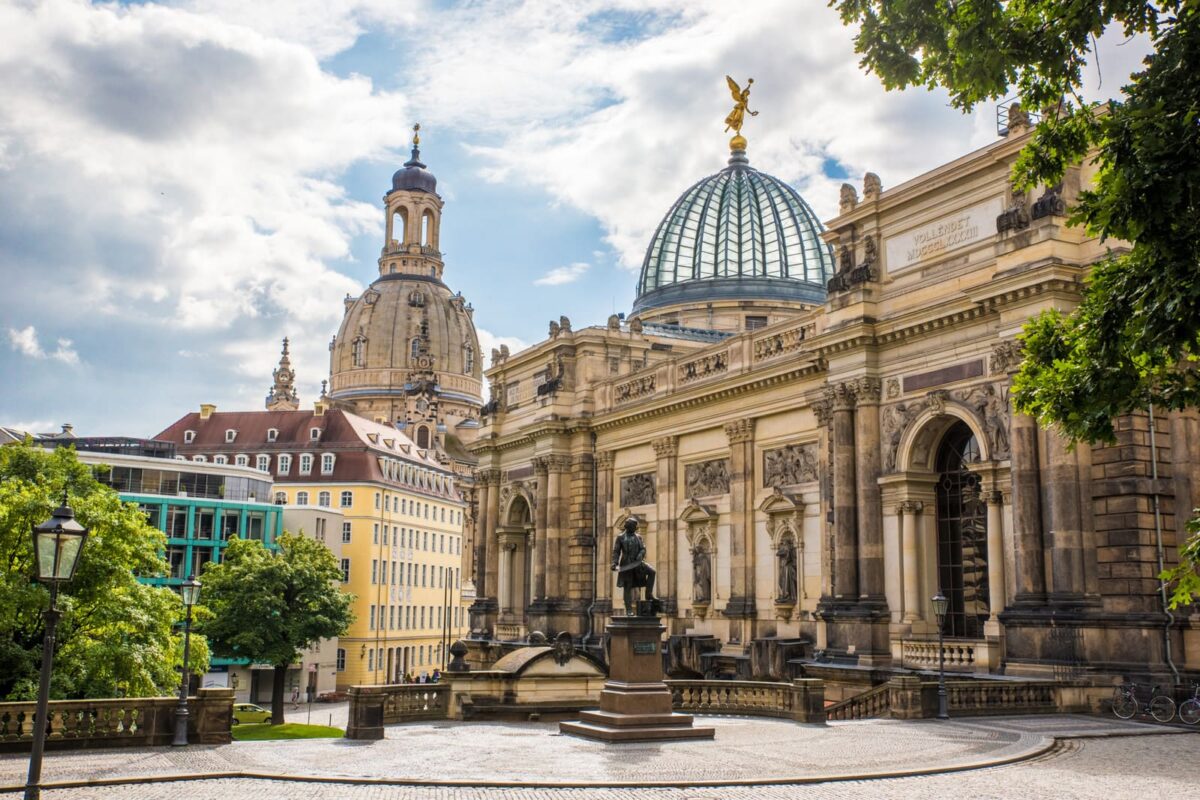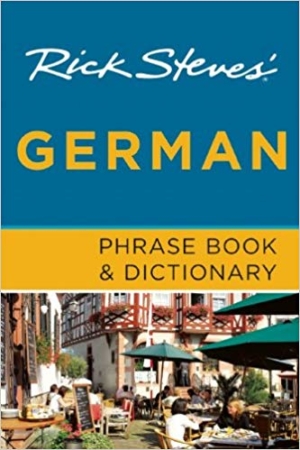With 2 weeks in Germany you’ll have enough time to see and do it all, whether it’s clubbing in Berlin or soaking up the medieval history of Nürnberg. Here’s how to make the most of your Germany itinerary!
The Ultimate 2 Week Germany Itinerary
Everyone has a different idea of what the perfect Germany itinerary entails. Maybe it’s spending the day exploring Nürnberg’s medieval history. Or perhaps it’s knocking back a few liters of beer and devouring a couple of pork sausages at Oktoberfest. With 2 weeks in Germany, you can do it all!
You’ll shop for fish in Hamburg, channel your inner hipster in Berlin, and folk dance your way through Munich.
Although Germany is small in size, it has a huge population made up of very different cultures. For example, Bavaria in the south feels like a whole different world compared to the north.
With this Germany itinerary, you’ll get to experience the full range of what Germany has to offer. Here’s how to spend 2 weeks in Germany the right way.
How to Get Around Germany
Germany is a relatively small country, and most cities can be easily reached within just a few hours of each other. For this reason, traveling by train is one fastest and most reliable option during your Germany itinerary.
If you’re booking a high-speed train, it’s recommended that you book as early as possible. Ticket prices tend to increase as the date gets closer, which means prices could double if you wait too long.
A long-distance bus is another option for traveling 2 weeks in Germany. Although the travel duration may be longer, coaches are much cheaper than trains. And unlike the trains, bus tickets can be purchased last minute or even the day of your journey.
Train and bus tickets for Germany can be purchased directly with omio.com up to 6 months before your departure date.
How to Spend 2 Weeks in Germany
Germany is one of Europe’s largest and most powerful countries. And while 2 weeks in Germany will give you a broad overview of the country, more time will allow you to soak in the culture.
If you have more time to add to your Germany itinerary, you can always stay longer in each city. This allows you to visit more attractions and gain a deeper appreciation for the country.
Day 1-3: Get Cultural in Cologne
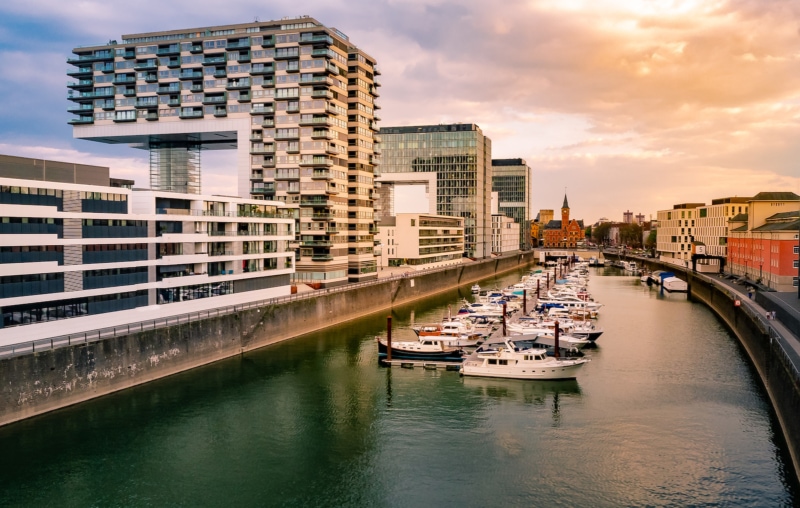
As the cultural center of Germany’s Rhineland, Cologne is teeming with beautiful parks, world-class museums, and trendy neighborhoods.
But as one of the most bombed cities during WWII, Cologne’s tumultuous past has compromised much of the city’s cultural landscape. Unlike other places in Germany, Cologne’s skyline is mainly made up of reconstructed post-war buildings. However, this bustling city is an ideal first stop on your Germany itinerary.
Step Inside the Cologne Cathedral
Nestled on the bank of the Rhine River is the city’s most iconic landmark, the Cologne Cathedral. Standing over 500 feet tall, it’s also the tallest twin-spired church in the world.
Inside, you’ll see the impressive Shrine of the Three Holy Kings: a 13th-century golden sarcophagus. And on the southern side of the cathedral, don’t miss the modern stained glass window. This unique masterpiece was designed by German artist Gerhard Richter and is the only modern window in the cathedral.
Drink Kölsch in Old Town
Step back several hundred years as you stroll through the Cologne’s charming historic city center. Lined with narrow, cobblestone alleys and traditional old houses, the Old Town is the beating heart of Cologne, and one of the most idyllic towns on this Germany itinerary.
Stop by a Brauhaus, or brewery, to sample Cologne’s most famous beverage, the Kölsch. This light beer is served in skinny 20-centiliter glasses which preserve the temperature and freshness. Once the Kölsch is empty (it only takes a few sips), a new one will be automatically brought to you.
Soar Above the City in the Cologne Cable Car
For sweeping views of the city, hop aboard the Cologne cable car. Built in 1957, the cable car was the first gondola to cross a river, which makes it one of the most unique methods of transportation in Germany.
The scenic ride takes you over the Rhine River, where you’ll enjoy panoramic views of Old Town and the Cologne Cathedral.
Shop and Dine in Ehrenfeld
The vibrant community of Ehrenfeld is easily the trendiest and most diverse neighborhood in Cologne. Filled with coffee shops, independent boutiques and gourmet restaurants, Ehrenfeld is buzzing at all hours of the day.
If you want to experience the city like a true Kölner, spend the day wandering the lively neighborhood of Ehrenfeld.
Where to Stay in Cologne
From the historic city center to the modern high rises in central Neustadt, Cologne is filled with hotels and hostels for every type of traveler.
If you’re looking to stay close to most major attractions, we recommend finding a hotel in the Old Town. There are several international hotel chains along the Rhine that offer unobstructed views of the river and surrounding areas.
For a more authentic experience, stay in one of the smaller neighborhoods around the city center. Ehrenfeld, Belgisches Viertel, and Nippes are just a few places where you can see traditional daily life.
- Luxury Hotels:
- Boutique Hotels:
- Mid-Range Hotels:
- Hostels:
How to Get from Cologne to Hamburg
The easiest (and fastest) way to travel from Cologne to Hamburg is by train. Leaving from Cologne Main Station, the high-speed train only takes roughly 3.5 hours.
On the other hand, you can also take a one-hour nonstop flight to Hamburg. But between driving to the airport, check-in, and security, you won’t be saving much time compared to taking the train.
Day 3-6: Explore Hamburg Like a Local
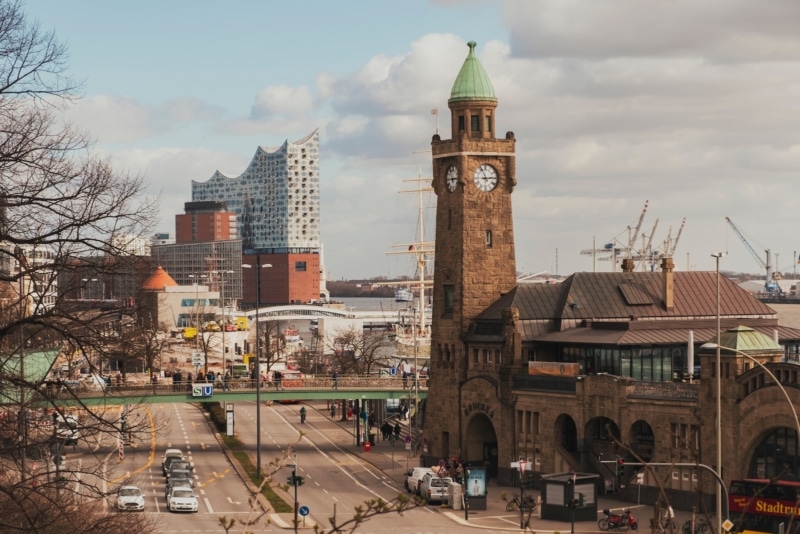
With winding canals and a sparkling modern skyline, Hamburg is a unique city to visit on your Germany itinerary. As the country’s second-largest city, this port-side town is filled with centuries of maritime history. Known for its impressive harbor, Hamburg has transformed from a sleepy fisherman’s town to a busy economic and commercial hub.
Marvel at the Elbphilharmonie
Located on the peninsula of the Elbe River, Hamburg’s Elbphilharmonie concert hall is one of the tallest and most impressive buildings in the city. The modern glass structure is built on top of a mid-century brick warehouse and resembles a ship sailing through the ocean waves.
Elphie’s unique architecture is worth visiting on its own. However, it’s the interior acoustics that has made this concert hall world famous. Built with 10,000 sound dispersing drywall plates, the concert hall can fit over 2,000 visitors.
Party in the Reeperbahn
As the heart of Hamburg’s nightlife scene, the vibrant Reeperbahn district is bustling late into the night.
As you walk through the streets, you’ll see why locals have nicknamed Reeperbahn “the most sinful mile.” Not only is the neighborhood overflowing with bars and nightclubs, but it’s also home to several strip clubs and brothels.
But despite its once seedy reputation, Reeperbahn is still one of the coolest entertainment districts in Hamburg.
Eat Your Way Through the Hamburger Fischmarkt
Every Sunday morning, the Hamburger Fischmarkt comes to life as farmers, fishers and food vendors set up shop. This outdoor market has been a German institution since 1703 and continues to attract visitors throughout the entire year.
Here, you can shop for locally caught salmon, dine on fresh oysters, and even listen to live jazz music. Besides seafood, you’ll also find stalls selling fruits, vegetables, clothes, and of course, traditional souvenirs.
Walk Through Speicherstadt
No trip to Hamburg would be complete without a visit to the UNESCO World Heritage site of Speicherstadt. Connected by canals, bridges, and narrow streets, Speicherstadt is 260,000 square meters of harborside brick warehouses. Inside the old warehouses, you’ll find museums, restaurants, and coffee shops to keep you entertained.
Whether you’re exploring the Hamburg Dungeon, taking a ride on the miniature railway, or indulging in gourmet gastronomy, you’ll find something fun to do in Speicherstadt.
Where to Stay in Hamburg
As the second-largest city in Germany, Hamburg is in no shortage of accommodation. You can find everything from charming Airbnbs to luxury boutiques and everything in between.
For historic architecture and culture, consider staying in the Altstadt (Old Town). If you’d rather mingle with hipsters and artists, check out the quirky neighborhood of Schanzenviertel. And if you want to party until the sun comes up, then look no further than the bustling St. Pauli district.
- Luxury Hotels: GINN Hotel Hamburg Elbspeicher, Ruby Lotti Hotel Hamburg, Scandic Hamburg Emporio, Steigenberger Hotel Hamburg,
- Boutique Hotels: Volksshule, Hotel Alsterblick, Hotel Europäischer Hof Hamburg, Adina Apartment Hotel Hamburg Speicherstadt
- Mid-Range Hotels: Best Western Plaza Hotel Hamburg, Apricot Hotel, IntercityHotel Hamburg Dammtor-Messe, Novum Hotel City Apart Hamburg
- Hostels: MEININGER Hamburg City Center , Backpackers St. Pauli , a&o Hamburg City , Instant Sleep Backpacker Hostel
How to Get from Hamburg to Berlin
After spending a few days in Hamburg, your next stop on your Germany itinerary is Berlin. If you take the high-speed train, you’ll arrive at the Berlin central station in just two hours. From there, you can easily make your way to the different neighborhoods around the city.
If price is a factor, then traveling by bus is also possible. FlixBus offers nonstop routes from Hamburg to Berlin for just a few euros per person. Best of all, the entire trip only takes three hours.
Day 6-9: See Berlin’s Alternative Side
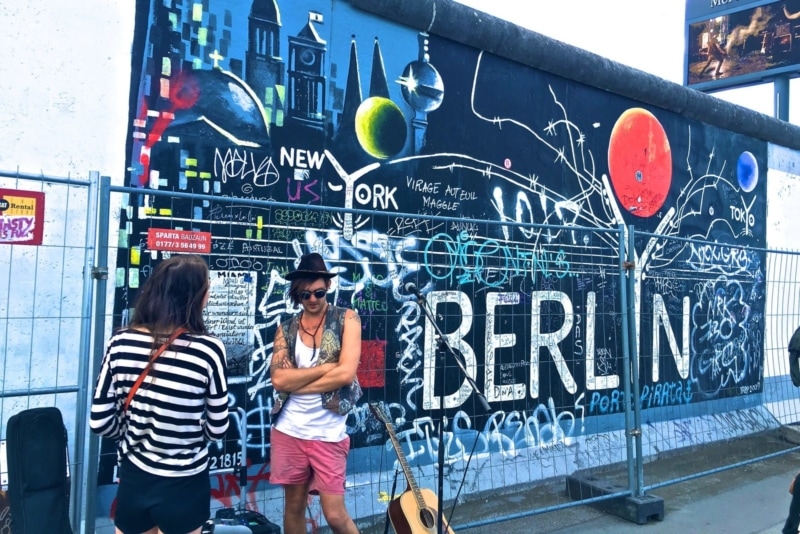
There’s no place quite like Berlin. In fact, Berlin is so unique that many people don’t even consider it to be part of Germany. This progressive, edgy city oozes coolness out of every pore and welcomes visitors and travelers from all over the world.
Whether you’re a history buff, creative artist or late-night party goer, you’ll find what you’re looking for in mesmerizing Berlin.
Admire the Street Art
Berlin is a creative city, and colorful street art is a testament to its unique and alternative lifestyle. Although you can find these larger-than-life masterpieces on most street corners, some places are more famous than others.
With over 100 international artists, the East Side Gallery of the Berlin Wall is the city’s most recognized graffiti area. Don’t forget to also visit Dircksenstrasse, Factory 23, and Lake Tegel Art Park for more amazing street art.
Cruise Down the Spree
To see Berlin from a unique perspective, hop aboard one of the many boat cruises down the Spree River. Snaking through Berlin Mitte, the Spree River is surrounded by the city’s most iconic buildings, including the parliamentary quarter, Museum Island, and the Berlin Cathedral.
Choose between a historic city tour, city lights night cruise, or even a hop-on-hop-off catamaran.
Uncover Berlin’s History
Berlin’s history is, to say the least, complex. However, the city is filled with landmarks and remnants of Germany’s separation, as well as its unification. If you’re looking to learn more about Berlin’s history, then there are a few sites you need to visit.
Of course, no trip to Berlin would be complete without a visit to the Berlin Wall (especially at the East Side Gallery) or the striking Memorial to the Murdered Jews of Europe. Checkpoint Charlie and Brandenburg Gate are two other iconic places that have left their mark on German history.
Dance the Night Away
The club scene in Berlin is, to put it gently, insane. Since most clubs don’t open until midnight, dancers, ravers, and party-goers arrive after 2 or 3 am. And since there are no fixed closing hours, many people stay until the next morning.
For a high-end nightlife experience, visit the clubs in Mitte or Prenzlauer Berg. But if you’re looking for something more underground and alternative, then visit ://about blank (yes that’s the name) in Friedrichshain or Arena Club in Kreuzberg.
Where to Stay in Berlin
Unlike most cities in the world, Berlin doesn’t have a city center per se. That just means that you can find accommodation in one of the many trendy neighborhoods scattered around the city.
For first time visitors, we recommend staying in the Mitte, which is close to Berlin’s main attractions. If you’re sticking to a budget, you can find alternative hostels in the funky districts of Friedrichshain or Kreuzberg.
- Luxury Hotels: Hotel ZOE by AMANO Group, RIU Plaza Berlin am Kurfürstendamm, The Dude Berlin Mitte, Hotel am Wasserturm
- Boutique Hotels: the nui HIDE, Garden Living Boutique Hotel, Honigmond Boutique Hotel, Mondrian Suites Berlin am Checkpoint Charlie
- Mid-Range Hotels: MEININGER Hotel Berlin Hauptbahnhof, Hampton By Hilton Berlin City East Side Gallery, Motel One Berlin-Alexanderplatz, Crowne Plaza Berlin – Potsdamer Platz
- Hostels: St Christopher’s Berlin Alexanderplatz , Heart of Gold Hostel , PLUS Berlin , Grand Hostel Berlin Classic
How to Get from Berlin to Dresden
Located just 120 miles from Berlin, Dresden can be reached by train, car or bus. The Eurocity (EC) train is the most efficient option and takes two hours from Berlin.
You can also rent a car (and speed down the world-famous Autobahn) to get from Berlin to Dresden. The drive also takes around two hours.
Finally, the cheapest option is to take a bus. It takes slightly longer than a train or car, but you can’t beat the ticket price. Some buses also come with wifi, electrical outlets, and snacks.
Day 9-11: Explore History in Dresden
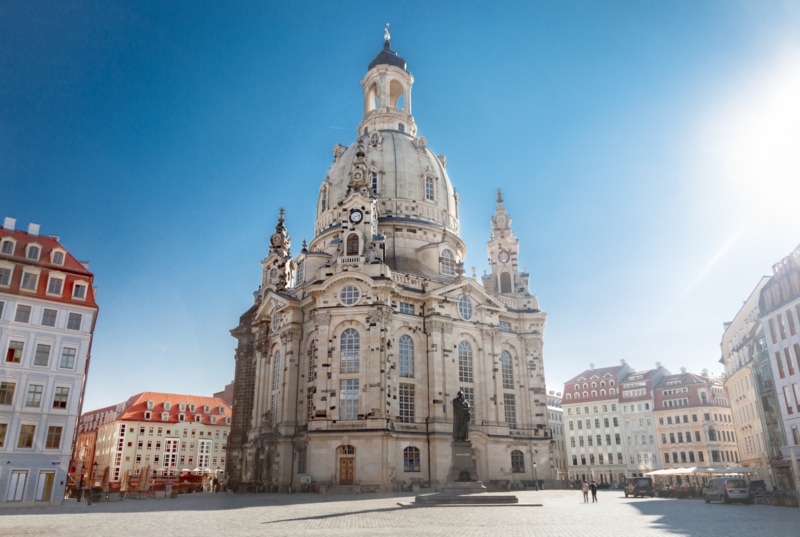
The affluent and historic city of Dresden is a hidden gem on this Germany itinerary. Although it was heavily destroyed during the war, the German government invested time and money to rebuild the center after the reunification. Nowadays, Dresden’s skyline is a mix of Baroque spires, royal palaces, and grandiose cathedrals.
But Dresden isn’t only art and architecture. It’s also home to quirky neighborhoods and eclectic restaurants that are sure to delight any traveler.
Admire the Frauenkirche Dresden
Considered the signature icon of Dresden, the Frauenkirche Dresden is a remarkable church located in the center of the city. Although it was initially built in the 11th century, WWII air-raids burned the entire church to the ground. It was recently rebuilt in 2005 and stands as one of the city’s most popular attractions.
It’s free to enter the Frauenkirche Dresden, but we recommend spending the extra cost to climb to the top of the dome. From there, you’ll have unobstructed views of Dresden and the riverfront.
Wander Around the Neustadt
Situated across the river from the historic city center is Neustadt, Dresden’s funkiest neighborhood. Start your day in the Baroque Quarter, which is situated in the inner part of Neustadt. This elegant street is home to cute cafes, trendy boutiques, and independent restaurants.
From there, make your way to the off-the-beaten-path Kunsthofpassage area. This complex of courtyards is covered in graffiti and art installations, which makes it one of Dresden’s best-kept secrets.
Get Cultured at Semperoper
For a taste of luxury, head to the Semperoper Opera House. Located on the banks of the Elbe River, the Semperoper was also part of the city’s reconstruction effort. It was rebuilt in the 1980s and is now home to Saxon State Orchestra and the Saxon State Ballet.
Although you can book a guided tour of the building, the best way to visit Semperoper is by attending a live performance. You’ll have the opportunity to walk the same grounds where Richard Wagner and Richard Strauss made their debuts.
Where to Stay in Dresden
Ideally, the best place to stay in Dresden is either in the Altstadt or Neustadt.
If you’re looking for a luxury boutique or high-end hotel, then you’ll have no problem finding accommodation in the beautifully restored neighborhood of the Altstadt. But if you prefer something more unique, then consider a hip hostel or alternative hotel in the Neustadt.
- Luxury Hotels: Hotel Indigo Dresden – Wettiner Platz, Romantik Hotel Bülow Residenz, Hotel Suitess, Gewandhaus Dresden, Autograph Collection
- Boutique Hotels: Hotel Kipping, Heinrich Schütz Residenz, Penck Hotel Dresden, Star Inn Hotel Premium Dresden im Haus Altmarkt, by Quality
- Mid-Range Hotels: ibis Dresden Zentrum, Motel One Dresden – Palaisplatz, CityHotel Stadt Dresden, Hotel Am Terrassenufer, Holiday Inn Express Dresden City Centre
- Hostels: Lollis Homestay , Hostel Mondpalast , a&o Dresden Hauptbahnhof , Grand Hostel Berlin Classic
How to Get from Dresden to Munich
After Dresden, it’s time to make your way down south to Bavaria, your last stop on your Germany itinerary. Although train travel is easy and efficient, the average journey time is around four to five hours. You’ll also need to transfer in Leipzig, which can add time to your trip.
The fastest way to get to Munich is by plane. Flights are under an hour, but you’ll need to allow extra time to get through check-in and security.
If time isn’t a concern, then you can save money by taking the bus. This six or seven-hour journey only costs a few bucks and goes directly from Dresden to Munich.
Day 12-14: Experience Bavaria in Munich
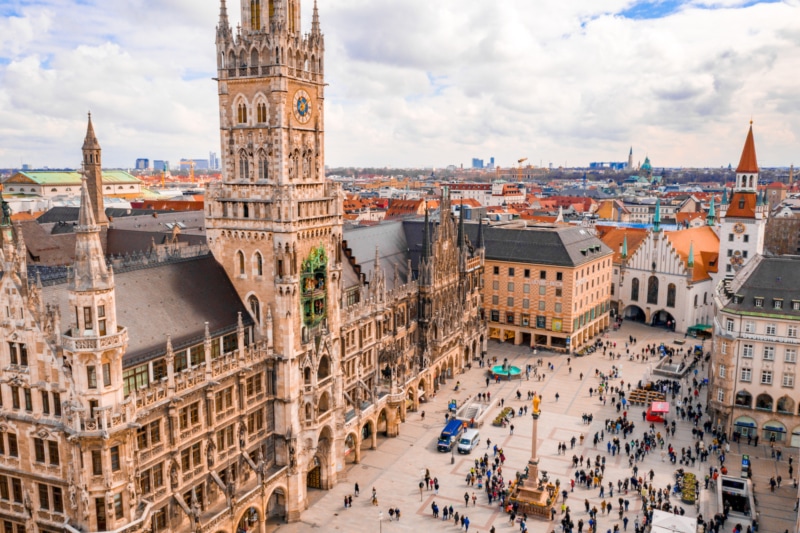
Home to lederhosen, liters of beer, and traditional Oom-pah music, Bavaria is what most people think of when they imagine German culture. And in its capital city of Munich, you can explore centuries of fascinating German culture and history.
Snack Your Way Through Viktualienmarkt
Located in the heart of Munich’s Altstadt, Viktualienmarkt is a foodie’s paradise and a must-see stop on your Germany itinerary. The oldest market in the city is a hub of fresh produce, mouth-watering meats and cheeses, and tons of classic Bavarian snacks.
Although the market is open every day, we recommend visiting in the morning or during lunch. Grab a pint of German lager and a hot bratwurst and sit down in the outdoor beer garden. You won’t find a better people-watching spot than Viktualienmarkt.
Relax in the English Garden
Stretching down the banks of the Isar River is Munich’s largest park, the English Garden. Filled with dense forests, crystal clear lakes, and grassy fields, the sprawling English Garden is the best way to spend a warm day. In fact, you’ll often find sunbathers and picnic-goers scattered throughout the park.
And for something different, head to the Eisbachwelle to catch amateur and professional surfers. Donning wet suits, these surfers ride through the artificial waves of the river every day of the year.
Drink in a Classic Beer Garden
Bavarians take their beer culture very seriously in Munich. And if the weather is beautiful, there’s no better place to enjoy a fresh liter of beer than in one of the many beer gardens.
Serving up ice, cold glasses of Helles (pale German lager) or Weissbier (wheat beer), the beer gardens are packed at all hours of the day. You can bring your own picnic, or purchase traditional dishes like schnitzel, giant pretzels, and sausages.
Some of our favorite beer gardens are all within walking distance from the city center. Check out Augustiner Keller, The Chinese Tower in the English Garden, and of course, the famous Hofbräuhaus.
Explore Olympiapark
When Munich hosted the 1972 Summer Olympics, they built an entire park and village that can still be visited today. Located on the northern end of the city, Olympiapark is a great way to spend a free day in Munich.
Catch a concert in Olympic Stadium, visit the sea creatures in the sea life center, or ride to the top of the Olympic Tower. If you happen to come during the summer, you can also attend one of the many festivals that take place in the park.
Where to Stay in Munich
Munich has a variety of accommodation types for every kind of interest and budget. Luxury and international hotels are located mainly in the Altstadt (Old Town). If price is a concern, then you’ll find cheaper hotels and hostels dotted around the central train station, Hauptbahnhof.
For a more authentic experience, stay in a hotel or hostel in one of Munich’s other neighborhoods. Schwabing, Maxvorstadt and Haidhausen are just a few trendy districts within walking distance of the city center.
- Luxury Hotels: Parkhotel Rothof, Hotel im Hof, Hotel Lifestyle, Inspire Hotel
- Boutique Hotels: Bavaria Boutique Hotel, Boutique Hotel Splendid-Dollmann, Steigenberger Hotel München, Eurostars Book Hotel
- Mid-Range Hotels: Holiday Inn Munich City Centre, Hotel Munich City, ArtHotel Munich, Hotel ADRIA München
- Hostels: Euro Youth Hostel , Wombats City Hostel Munich , MEININGER Munich City Center , Smart Stay Hostel Munich City
Ending Your Trip in Munich
After spending a whirlwind 2 weeks in Germany, it’s time to head back home. This action-packed Germany itinerary took you across the country and through some of its most amazing sights and cities.
Munich International Airport is just 20 miles outside the city and serves many direct routes back to the US. If you’re traveling internationally, make sure to arrive at the airport at least 2 hours before your flight. The lines to check-in luggage can be long and may take anywhere from 15 – 45 minutes.
Your 2 weeks in Germany may have gone by in the blink of an eye, but you’ll have lasting memories of your time in Deutschland for years to come!
How Much Will 2 Weeks in Germany Cost?
Despite what you may think, traveling for 2 weeks in Germany doesn’t have to cost an arm and a leg. In many ways, the cost of your trip will depend on how you choose to travel.
Transportation
Flying into Germany will probably be the most significant expense of your trip. Frankfurt, Cologne, and Munich are the three largest international hubs for getting to and from the US. Depending on what time of the year you travel, seats can cost between $400 – $1000 each.
If you’re traveling between different cities in Germany, you can take trains or buses. Train travel is the most efficient way to travel, and if you book early enough, you can score a great deal on tickets. But if you wait until the last minute, train tickets can cost upwards of $170 each way.
Traveling by bus, like FlixBus or BlaBlaBus, is the most affordable way to get around Germany (and Europe in general). Tickets can be booked the same day and range anywhere between $5 – $40. Use Omio to plan your trip!
Accommodation
The cost of staying for two weeks in Germany will depend significantly on the type of accommodation you choose.
German hostels are some of the cleanest in Europe and will cost anywhere from $30-$50 a night in a shared dorm room. If you want more privacy, then you can also opt for a mid-range hotel, which will cost around $100 in Germany.
It’s also important to note that hotel prices will increase during special events. If you go to Cologne during Carnival, or Munich during Oktoberfest, you can expect to pay a pretty penny. It’s not uncommon for hotels to cost triple or even quadruple what they normally would.
Food and Drink
In Germany, the cost of food and drink will greatly depend on the type of restaurant you choose. For example, a meal in a traditional German pub and restaurant can cost between $10-$20 per entree.
If you want to save money, then cooking your own meals is another option. Fresh produce and groceries are far cheaper in Germany than they are in the US.
The cost of alcohol can also be cheaper in Germany. Although you’ll find swanky lounges that sell cocktails for $10-$15 a pop, German beer is actually pretty affordable. You’ll pay under $2 a bottle of beer in the grocery store, and around $3 in a restaurant.
What to Pack for 2 Weeks in Germany
No matter where you go in the world, you’ll want to make sure you have the latest travel accessories. Here are a few gadgets that will make your 2 weeks in Germany easier (not to mention more fun)!
Comfortable Walking Shoes
Comfortable sneakers are crucial for walking through the cobblestone old cities of Germany. And there’s no better brand to rock than Germany’s own Puma. These stylish sneakers can be dressed up or down, which means you can easily hit the bars after you’ve been touring the city all day.
They come in a whole assortment of colors and styles too. Take your pick!
Germany Travel Adapter

When packing for 2 weeks in Germany, don’t forget to add a German power adaptor to your list. The VINTAR International Power Adaptor coverts your American plugs into European Type C outlets. Plus they come with USB slots for charging your extra devices.
These might look bulky, but they’re very mini at just 2.8×2.6×2.3 inches! If you don’t want to fry your electronics, these adapters are vital.
Packing Cubes

Are you an over-packer? To keep your clothes and accessories organized, invest in a durable set of Eagle Creek packing cubes. Nothing is more frustrating than digging around in your carry-on luggage for a clean pair of undies!
And if you decide to pick up a dirndl or lederhosen, then packing cubes will help you save space in your suitcase.
Portable Charger
While traveling, it’s easy to drain your phone battery by looking up restaurant reviews or snapping photos. That’s why it’s handy to have a portable charger, like the Anker PowerCore 5000. It can charge your smartphone up to two full times, so you’ll never be stuck without power during your 2 weeks in Germany.
This charger’s tubular ultra-compact shape also makes it easy to slip into any pocket, bag, or purse.
Tile Tracker
Generally speaking, petty theft is relatively uncommon in Germany. But if you do happen to lose your wallet or camera, you’ll be able to track them down with Tile. It has integrated Bluetooth so that you can easily ring your Tile to locate the last place you put it, and it’s small enough to slide into a wallet or luggage pocket.
Another fun feature: if you’ve lost your keys, and your Tile passes within range of anyone else in the Tile community, they’ll get notified!
German Pocket Dictionary
Although English is spoken in larger cities in Germany, it’s still a good idea to learn a few common phrases. It’s also just a nice sign of respect to attempt speaking basic German with the locals, even if the conversation quickly switches to English.
With Rick Steves’ German Phrase Book and Dictionary, you’ll feel comfortable saying “Guten Tag” to everyone you meet! It offers key phrases for everyday use, complete with phonetic spelling.
Travel Insurance in Germany
Even if it is safe to travel to Germany it’s crucial to have travel insurance to protect you. If your cross-country train is canceled or if you get sick from one too many sausages, you’ll be thankful to have coverage from one of the best travel insurance companies.
Don’t believe me? Here are 7 Reasons You Need Travel Insurance in Germany.
Generally speaking, travel insurance covers the cost of medical bills and any other travel mishaps you may encounter on your 2 weeks in Germany. And if the airline loses your luggage or your iPad gets stolen on your way back from the beer garden, then travel insurance covers that too.
Final Thoughts
Between the charming old towns to the harborside villages, your Germany itinerary has something intriguing for every type of traveler.
And although this Germany itinerary focuses on the most popular attractions in each city, there’s still so much to explore. You can always customize your own Germany itinerary by venturing off the beaten path. Take the advice from locals, try out that cool new restaurant, and have an open mind wherever your journey takes you.
READ MORE:
Germany Itinerary FAQs
-
How many days is enough for Germany?
I recommend taking at least 10 days for a trip to Germany.
-
Is 7 days enough in Germany?
7 days is enough to enjoy much that Germany has to offer, but you can get a more immersive experience by staying longer.
-
What months are best to travel to Germany?
September is the best month to travel to Germany. You can warm weather and can be immersed in German culture during Oktoberfest.
-
What is the cheapest time to go to Germany?
Late winter months (between January and March) are the cheapest times to travel to Germany.
-
What is the cheapest month to fly to Germany?
January is usually the cheapest month to fly to Germany.
